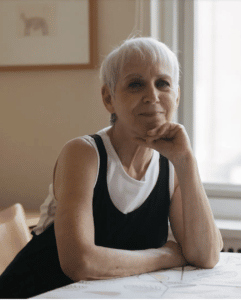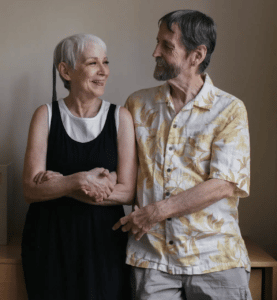I’ve known for a long time that aging was going to be an important part of my life. Not just my personal aging journey, but the whole concept of aging and participating in the community of aging. At 50, I began searching for articles on aging. That was almost 21 years ago and there wasn’t much happening around that topic then. No social media and what I did read was negative and disparaging. But I knew (that feeling in your gut) that it was my calling, so I kept going. Kept researching, and asking questions. I taught Yoga and Menopause classes in 1999 to bring awareness to women on how their bodies would change and provided physical, mental, dietary and spiritual options for them. I’ve also spoken to corporate groups on aging (that was darn HARD, but I will always remember one man, bless him, came up to me after a presentation and said “this is really good stuff you’ve given us. Thank you.” That was enough to keep me going. And finally, the course I created several years ago — The Art of Mindful Aging — will be available online later this year.
If aging is my calling, then color and style is my passion. I can’t let go of either one. They are both central to my life purpose. In the past I’ve separated them slightly, thinking they were too different to live together. I’ve changed my mind and now believe that not only can they live together, they belong together. Why should aging be separate from beauty and vice versa? Going forward, my new format will be celebrating these topics in tandem.
For those of you that signed up for the aging freebie several years ago, I do understand if this format no longer serves you. And for my mature beauty & style friends, if this layout doesn’t appeal to you, I also understand if you must depart.
PERKS OF A COLOR PURIST
In 2018, I had my color palette updated. I was given a carefully curated palette of colors that represented my color quality, personality and essence. I’d spent almost ten years searching for my best colors, so I made a promise to myself to follow the dictates of that palette as a way of exploring what was possible with a limited number of colors. The video below discusses my insights.
For a more detailed discussion on how to maximize a 17-stick personal color palette, here is a video of color colleague Joy Overstreet, Color and Image Consultant, and myself sharing ideas. Joy can be found @ https://www.colorstylepdx.com
I’d enjoy hearing your experiences with your color palette. Are you finding you have enough? Are you experimenting with each color? Have you tried pairing the colors from your sacred triad? Do you lean more toward your neutrals or do you prefer the actively colorful side of your palette? Or, are you bored and looking for more color?
Older Singles Have Found a New Way to Partner Up: Living Apart Together
Fearing that a romantic attachment in later life will lead to full-time caregiving, many couples are choosing commitment without sharing a home.

Jill Spoon, 73, has lived in her Manhattan apartment since 1970. She and her partner are among those “living apart together,” meaning they are in long-term relationships without sharing a home.
Credit: Elizabeth D. Herman for The New York Times.
With greater longevity, the doubling of the divorce rate since the 1990s for people over 50 and evolving social norms, older people are increasingly re-partnering in various forms. Cohabitation, for example, is more often replacing remarriage following divorce or widowhood, said Susan L. Brown, a sociologist at Bowling Green State University in Ohio.
Demographers have coined the term “living apart together” — or LAT — to refer to older adults in committed, romantic relationships who decide not to live together or marry their partner. Instead, older adults in living apart together relationships maintain their own residences even as they spend significant time together. One researcher who has studied the phenomenon describes living apart together as an “emerging form of family.”
“A big attraction of LAT is to avoid the potential responsibility of being a full-time caregiver,” said Ingrid Arnet Connidis, an emerita sociology professor at Western University in London, Ontario. “Women cared for their children, parents and spouse, and want to avoid getting into these traditional gender roles.”
While researchers have not yet delved deeply into the demographics of those in LAT relationships, anecdotally it seems to be more prevalent among those at high enough socioeconomic levels to be able to maintain separate households. In general, there is evidence that wealthier people who are single later in life are more likely to re-partner.
THE ISSUE OF CAREGIVING
Allison Forti, a counseling professor at Wake Forest University, noted that some women may feel cultural and social expectations to serve as caregivers. “I think it’s important for women to know it is OK to not want to serve as a caregiver and to still hold value as women in society,” she said. Full-time caregiving “takes a significant physical and emotional toll on someone,” she noted. In a 2020 report from the National Alliance for Caregiving and AARP, 23% of Americans said caregiving had made their health worse.
In some cases, partners in the early stages of a living apart together relationship express reluctance to take on the role of a care partner. However, many of those partners offer assistance when medical problems arise. Although partners may decide not to live together or marry, many find themselves unwilling to simply walk away from relationships that become complicated by health concerns.

Credit: Elizabeth D. Herman for The New York Times
Six years ago when I started dating my beloved I knew I didn’t want to live together. Initially, I felt a little guilty, like I wasn’t “fully in or committed.” As time went on, friends and family asked of our “plans” meaning when are you moving in together or getting married. Michael had been married for 35 years, so getting hitched wasn’t paramount for him. I’d been blissfully single for 35 years and I wasn’t in a hurry to change my status. When their responses were delight and a solid thumbs up on my choice, I was astonished. “That’s the best of both worlds!” “You’ve made a great decision.” I wish I could do that!” The guilt dissipated. It wasn’t care-taking that bothered me, it was giving up the sweetness I felt as a thriving mature woman, the pleasure of my sacred space, the joy of being the commander-in-chief of my life, getting up @ 5am to practice yoga or bake a cake. I’d looked forward to experiencing this kind of freedom for a very long time and I wasn’t going to give it up easily. It doesn’t let me off the hook because relationship is clearly the hardest thing I’ve ever done. And I’ve found a way to be fully engaged while maintaining my sovereignty.
Intimate Relationships, Separate Households
While living apart together relationships have yet to become a dominant lifestyle choice among older adults, the numbers are increasing. A 2005 study found that approximately 7% of people between the ages of 57 and 85 categorized themselves as living apart together. A recent survey found that “partnered but unmarried” older adults accounted for about 8% of the total number of people surveyed. Among the partnered group, just under 40% were in living apart together relationships.
In some cases, seniors become involved in living apart together relationships after divorce or the death of a spouse. Rather than remarrying, these newly single adults decide to enjoy the benefits of a relationship without giving up their own households.
LAT relationships have raised a number of questions for researchers, such as the effects on seniors’ overall well-being and health. In addition, researchers wonder how adult children from previous relationships will respond to the couplings. Complications can ensue, for instance, when family members do not recognize or respect the relationship and do not keep partners informed of changes in health status.
Excerpted from: Older Singles Have Found a New Way to Partner Up: Living Apart by Francine Russo.
Check out Francine Russo’s book:
Love After 50: How to Find It, Enjoy It, and Keep It
In Love After 50, journalist Francine Russo interviewed the best experts in the field and dozens of couples to help show the way. Her “practical, excellent guide” (John Gottman, author of The Seven Principles for Making Marriage Work) includes advice like:
- How to recover from the emotional damage of divorce, the grief of widowhood, or a history of unfulfilling relationships
- How to build realistic requirements for a partner
- What attitudes to bring to dating
- How to overcome the psychical challenges of sex and embrace your erotic selves
- How to evaluate the financial, emotional, and practical results of marrying, living together, or living apart
- How to deal with (hostile) adult kids to safeguard your relationship and family
FOOD FOR THOUGHT
Age-defying Recipes from Martha Stewart
HAPPY NEW YEAR!
Welcome to 2023! Each New Year finds me in a class detailing the upcoming spiritual aspects and energies. It has always helped me prepare for what the year dishes up. Numerically, 2023 breaks down to a 7 (2+0+2+3=7) vibration which is the most spiritual of all numbers and years. My teacher of 30 years says it’s the year that belongs to God (Spirit, Source, Creator, the Universe, whatever you relate to) and promotes inner wisdom, reflection and faith. Additionally, according to Chinese astrology, beginning January 22, 2023 the Black Water Rabbit begins it’s reign until February 9th, 2024 and symbolizes longevity, peace, and prosperity.
Whatever your beliefs, I wish you a year of bountiful blessings.
To Midlife and Beyond in Fullness and Beauty,
Denise
